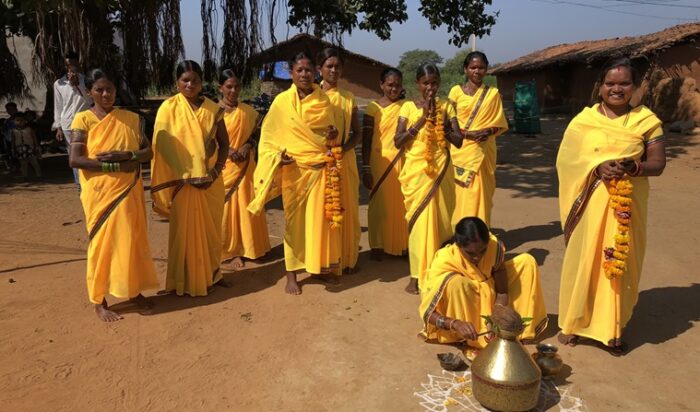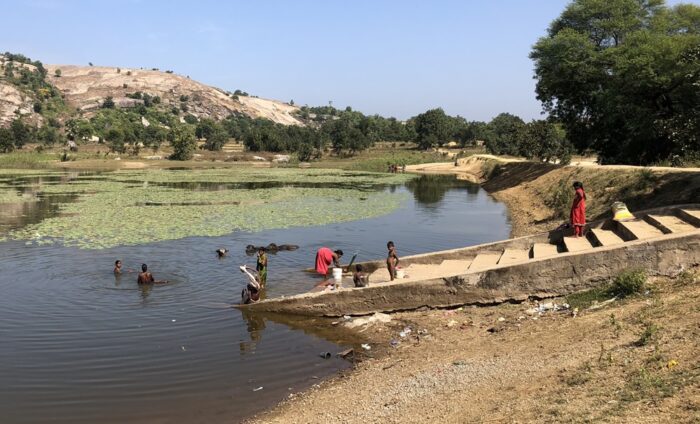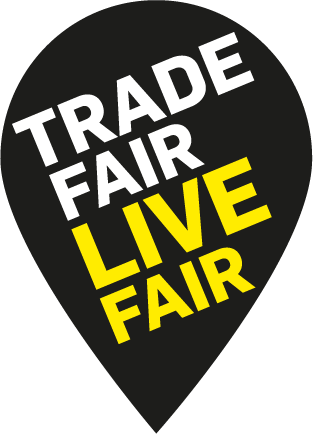The most anticipated and much-awaited event in VegFest 2023 is the VegFest Runway. A sustainable fashion show that has become a highlight of the festival. This year’s event resonated with creativity and resilience even in the face of a tropical storm. It showcased how fashion can contribute to preserving the environment and saving it from the climate crisis.
The VegFest Runway captivated a blend of innovative designs from three visionary fashion designers and a celebrity stylist. Together, they illustrated the impactful mantra of recycling, reusing, and reducing or the 3Rs. Through these compelling collections, the 3Rs define modern sustainable fashion.
A Showcase of Creativity and Sustainability
The first collection was called “Simply Trashion.” It captivated the audience with its transformative use of everyday recyclable materials. The designer turned empty plastic wrappers into stunning pieces. Shredded rice sacks were also used. They challenged conventional norms about waste by incorporating repurposed fabrics.
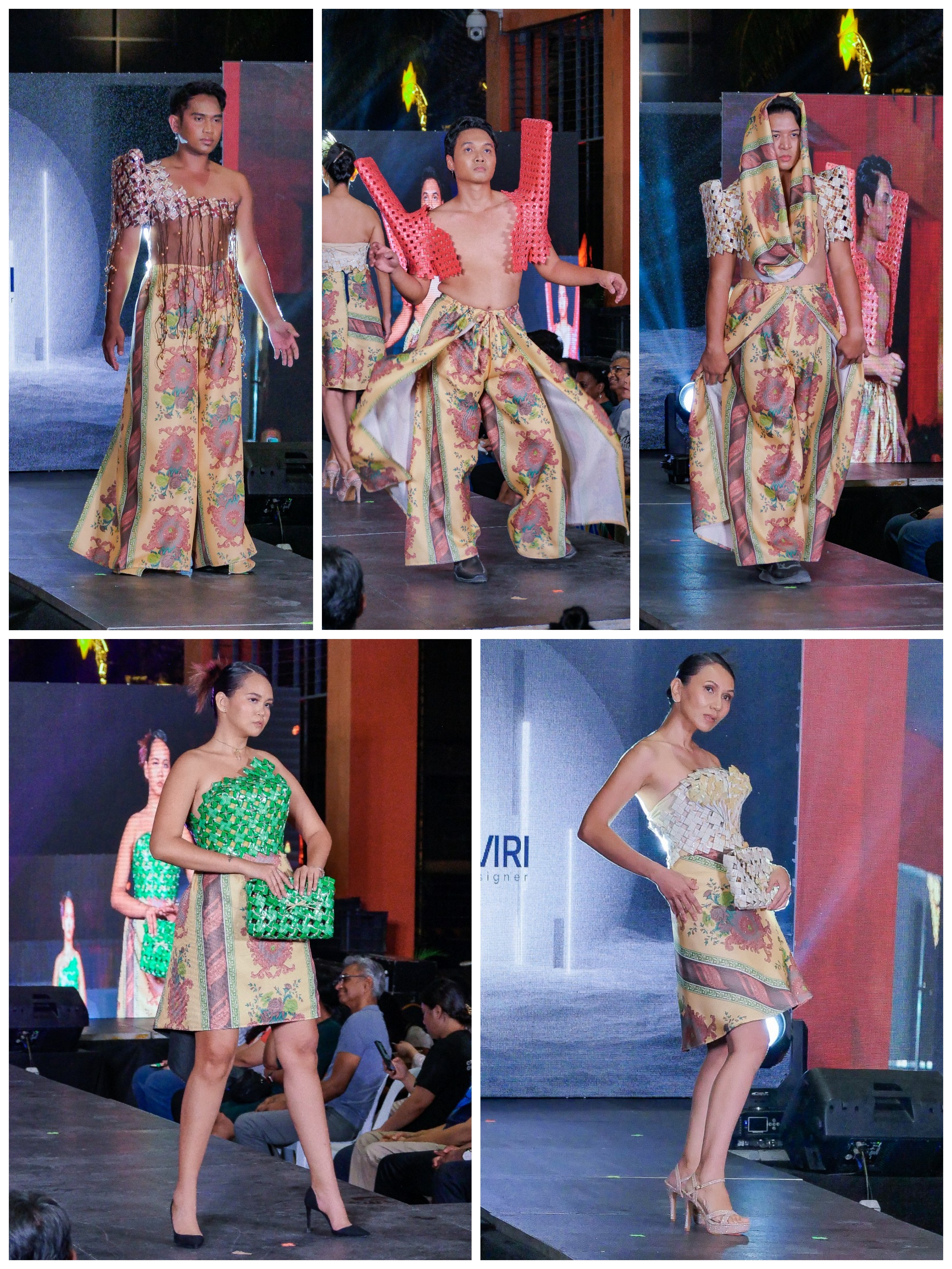
Leby Le Moría followed with a profound presentation. The attendees were treated to a collection that embodied years of introspection. The notion that vulnerability can be a source of strength is an inspiration. Each piece from her collection represented a chapter of her journey. Intricately woven with humanism and creativity.
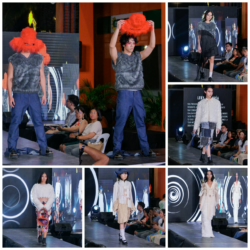
Next in line is Twinkle Ferraren’s Style Isle. The tropical landscapes of the Philippines influenced here we’ll renowned island wear designs. Putting together local artisans and indigenous tribes to encapsulate Filipino artistry. Ferraren’s collection showcased the rich Filipino heritage, and sustainably sourced textiles and accessories.
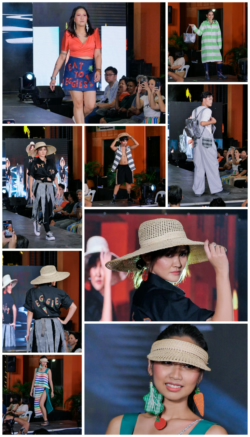
The show’s pulse quickened with celebrity eco-stylist and author Miss Kayce. She highlighted the vegan statement collection in advocating for positive change. Miss Kayce inspired the volunteer models to mix creatively and match pieces from their existing wardrobes. Aligned to their fashion choices with a vegan philosophy. A philosophy while promoting conscious consumerism.
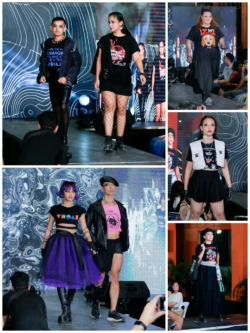
A Spotlight on Emerging Talents
The next day of VegFest 2024 is dedicated to students from SoFA Design Institute. They presented their unique street wear creations on the runway. Their instructor, Irene Grace Subang, guided their creativity to new heights. These budding designers utilized textile scraps donated by Barrios Studios.
Three esteemed experts in sustainable fashion judged the students. The judges are Prince Jimdel Ventura of Wear Forward, Buena Sawit of Barrios Studios, and celebrity stylist author Miss Kayce. They judged the students’ efforts across three categories: Best in Upcycled Construction, Most Innovative, and Best Collection. Additionally, the audience had the chance to vote for their favorite, culminating in an exhilarating People’s Choice award.
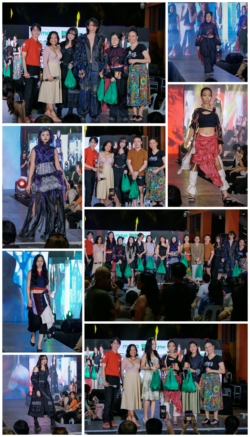
Embracing Eco-Consciousness
The VegFest Runway 2024 persevered to continue despite the looming threat of tropical storm Man-Yi. A powerful reminder of the fashion industry’s potential to drive environmental awareness. It served as a platform for creative expression and also as a conduit for inspiring actionable change.
VegFest Pilipinas, in collaboration with Fashion Revolution Philippines, reiterated its commitment to sustainable fashion. Leaving an indelible mark on the attendees and participants alike. The event successfully merged the worlds of fashion, environmentalism, and cultural heritage. It promoted a collective consciousness toward a more sustainable future.
As the final curtain fell, it was clear. The VegFest Runway has once again proved that style and sustainability can walk hand in hand. Where change is more than envisioned but it’s being woven into the very fabric of our lives.
Habi Philippine Textile Council (Habi) took a significant step to partner with Fashion Revolution Philippines (Fash Rev PH). They aim to promote sustainable and ethical fashion. They partnered for a series of engaging workshops during the Habi Market Fair. The event took place from October 18th to 20th, 2024, at the Glorietta Activity Center in Makati City. It highlighted the incredible talent of Filipino weavers. The beauty of natural textiles was also showcased. Additionally, the importance of supporting local brands was emphasized.
This partnership marked a first for Fash Rev PH. It merged their passion for ethical fashion with Habi’s dedication to preserving and promoting the heritage of Philippine textiles. The workshops were vibrant with creativity. They offered a unique opportunity for attendees to immerse themselves in the world of weaving. Additionally, they promoted sustainable practices.
The event kicked off with a captivating introduction to the art of weaving, led by Twinkle Ferraren. Participants experienced the joy of creating something with their own hands. This fostered a sense of accomplishment. It also sparked a creative fire within each attendee.
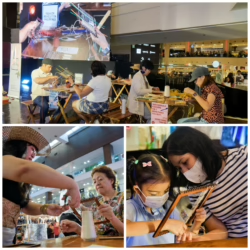
On the second day, Ili Likahaan led a mesmerizing Botanical Eco-printing workshop. Participants discovered the magic of transforming natural textiles using flowers and the rhythmic beat of hammers. This experience was not just about creating beautiful bandannas. It was a journey towards mindful crafting. It also served as a stress-relieving creative outlet.

The final day of the workshops showcased the diverse facets of textile artistry. Hiwaga Hands taught participants the art of visible mending. They used techniques like patchwork, embroidery, and sashiko. These techniques breathe new life into fabrics. Meanwhile, The Art of Yarn introduced children to the world of weaving. They used a small loom. This offered a valuable lesson in the craftsmanship and dedication of local weavers.
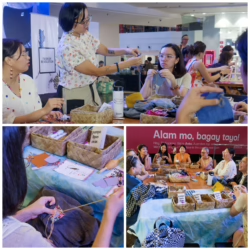
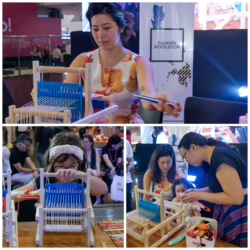
The workshops were a resounding success. Participants gained newfound skills. They also developed a deeper appreciation for the textiles they wear. Additionally, they established a connection to the rich heritage of Filipino weaving. This success demonstrates the power of collaboration. It highlights the growing movement towards conscious consumerism and ethical fashion in the Philippines. The success of this event is a beacon of hope. It inspires others to embrace sustainable fashion choices. It also encourages support for the talented artisans who bring these beautiful textiles to life.
On May 19th, 2024, Rizal Park Luneta transformed into a vibrant canvas of culture and eco-consciousness. The National Parks Development Committee (NPDC) joined forces with Fashion Revolution Philippines, SoFA Design Institute, and Urban Sketchers Manila to present a unique Flores de Mayo celebration: Fashionista Flores de Mayo.
This exciting event wasn’t just about religious devotion or showcasing stunning gowns. It was a beautiful fusion of tradition and environmental awareness. SoFA design students presented modern Filipiniana gowns and suits, all crafted with sustainability in mind.
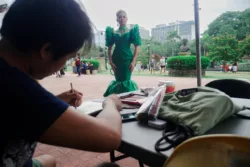 The festivities began at 5:00 pm, with Urban Sketchers Manila capturing the elegance of the “Reinas” (Queens) in their one-of-a-kind attire. As the day unfolded, the Santacruzan parade filled the air with a celebratory energy, snaking its way through the Central Section of Rizal Park.
The festivities began at 5:00 pm, with Urban Sketchers Manila capturing the elegance of the “Reinas” (Queens) in their one-of-a-kind attire. As the day unfolded, the Santacruzan parade filled the air with a celebratory energy, snaking its way through the Central Section of Rizal Park.
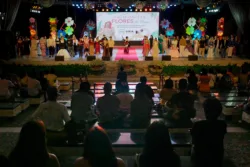
The highlight of the evening was the Santacruzan fashion show, held at the Open-Air Auditorium. Here, the public witnessed a modern interpretation of the Santacruzan tradition, where sustainable fashion took center stage.
But the sustainable fashion movement didn’t end there. From May 21st to 26th, an exhibit titled “Modern Filipin(ian)a: Reimagining Santacruzan Gowns” took place at The Gallery of Rizal Park Luneta. Visitors were invited to get a closer look at the eco-conscious gowns, sparking conversations about responsible fashion choices.
The Fashionista Flores de Mayo was a resounding success. It proved that cultural celebrations and environmental consciousness can go hand in hand, paving the way for a more sustainable future for fashion in the Philippines.
This post is a translation of a recent Guardian article exploring textile waste, written by journalist Tamsin Blanchard.
A tavalyi évben hatalmas mértékben növekedett a hipergyors divat, amely jelentős szénlábnyommal és hulladéktermeléssel jár. Mérgező mennyiségű poliészter ruha került legyártásra, illetve a szemétbe és ne feledjük, hogy mennyire szoros kapcsolat van a fosszilis tüzelőanyagok és a ruháinkban lévő szintetikus anyagok között.
“A fosszilis divat a fast fashion számos súlyos problémájának a középpontjában áll: olcsó anyagok, túlzott függőség a szintetikus anyagoktól, hulladékválság és az egyre növekvő kibocsátás” – állította a Fossil Fuel Fashion, egy új szervezet, amely a New York-i Klímahéten indult szeptemberben, és olyan szervezetek koalícióját tömöríti, amelyeknek célja a fosszilis tüzelőanyagok fokozatos kivonása az iparágból. A fosszilis tüzelőanyag-alapú poliészter olcsó, és a hipergyors divat kedvelt anyaga, amely továbbra is leuralja a piacot, annak ellenére, hogy júniusban számos kritika érte. A Shein hat divatipari influencert fizetett, hogy látogassanak el kínai gyáraikba és az influencerek ezután elragadó véleményeket osztottak meg a kulisszák mögül. A 66 milliárd dolláros divatmárka továbbra is arra ösztönöz minket, hogy olyan ruhákat vásároljunk, amelyekről nem is tudtuk, hogy szükségünk van rájuk, és amikre valójában biztosan nincs is szükségünk. A versenyfutás azonban csak most kezdődött meg. A kínai Temu nevű vásárlási alkalmazást, -amely a Sheint is megszorongatja a 99%-os kedvezményes ajánlataival-, már több mint 7 milliószor töltötték le, mióta áprilisban elindult az Egyesült Királyságban.
Nem csak rossz hírrel tudok szolgálni. A mezőgazdaság és a divat közötti kapcsolatról még soha nem esett ennyiszer szó; a “regeneratív” a tavalyi év egyik legelterjedtebb divatszava volt. Ahogy Safia Minney, a Fashion Declares alapítója elmagyarázza, a divat nem csak arról szól, hogy a gazdáknak biztosítaniuk kell a szén-dioxidot a talajban, hanem az egész folyamatról – a pamut, a kender, a len, a gyapjú és a bőr termesztésétől kezdve egészen a ruhadarabok életciklusának végéig. A regeneratív divat egyik győzelmére októberben került sor, amikor Justine Aldersey-Williams bemutatta az Egyesült Királyság első saját termesztésű, házi fonású farmerját, amely a lancashire-i Blackburnben termesztett lenből és gyapjúból készült.
2023 volt az az év is, amikor a hulladékkolonializmus szörnyű környezetszennyezése újra a figyelem középpontjába került. Februárban a ghánai Accra Kantamanto piacán működő The Or Foundation, amely a divat szemétproblémájának igazságtalanságával foglalkozik, közzétette a Stop Waste Colonialism (Állítsuk meg a hulladékgyarmatosítást) című jelentését. Ebben kifejtette, hogy “a divatipar a globális használtruha-kereskedelmet de facto hulladékkezelési stratégiaként használja“. Májusban ruházati kereskedők egy csoportja Brüsszelbe utazott, hogy megvitassák a döntéshozókkal a kiterjesztett gyártói felelősségről (EPR) szóló európai jogszabályokat. Fontos, hogy a kantamantói piacot védő szervezeti tag is részt vett ebben a beszélgetésben, mivel a világ textilhulladéka az ő küszöbükön végzi.
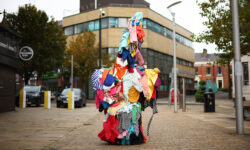
Jeremy Hutchison művész egy lépéssel tovább vitte a küszöbön lévő szemét gondolatát, amikor a “fogyasztás utáni imperializmus szörnyetegévé” vált, egy fulladozó, 2,5 méter magas textilzombi, a Dead White Man formájában. Az alkotás a The Or Foundationnel való együttműködésben készült, és a ghánai obroni wawu kifejezésre utalt, ami annyit tesz: halott fehér ember ruhája. A kantamantói piac kereskedői, így emlegetik a globális északról származó selejtes árukészletet. A Dead White Man októberben fellépett a brit textilbiennálén Blackburnben, majd rögtönzött látogatásokat tett pár ruházati beszállítónál, köztük a Marks & Spencernél. Az M&S egyike azoknak a márkáknak, amelyek címkéi gyakran megjelennek Accra strandjain.
Szeptemberben Clare Press, a Wardrobe Crisis podcast alapítója – amely a fenntartható divat iránt érdeklődők számára elengedhetetlen műsora – kiadta legújabb könyvét, a Wear Next-et: Fashioning the Future (A jövő divatja) című könyvét, amelyben számos ilyen problémára kínál megoldásokat. “A túltermelés és a hipersebesség a divatipar két legnagyobb problémája” – mondja. A Fashion Revolution éves Fashion Transparency Indexében arról számolt be, hogy a nagy divatmárkák 88%-a még mindig nem hozza nyilvánosságra éves termelési volumenét. Az Index szerint globálisan annyi ruha van a rendszerben, hogy a következő hat emberöltőnyi generációt fel tudnánk öltöztetni (ha a bolygó nem megy tönkre előtte).
Továbbá, tavaly kezdte el az európai jogalkotás beleásni magát a fast fashion szabályozásába. Decemberben az Európai Parlament az új “ökodizájn” keretrendszer részeként elfogadta az eladatlan ruhák, kiegészítők és lábbelik megsemmisítésének tilalmát, a ruházati cikkek pedig digitális termékútlevelet kapnak. A várhatóan 2026-ban hatályba lépő QR-kód nagyobb átláthatóságot biztosít majd a vásárlók számára az anyagokról, a gyártásról, sőt, még akár javítási tippeket is adhat. Szabályozás nélkül a márkák még mindig nem vállalnak felelősséget termékeikért, az általuk felhasznált anyagokért és ellátási láncukért. A jogalkotás végre elkezdi őket arra késztetni, hogy kollektív lépéseket tegyenek.
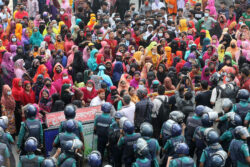
Azonban a ruhaipari munkások folyamatos kizsákmányolása sajnos világszerte folytatódott. 2023-ban volt 10 éve, hogy a bangladesi Dhakában található Rana Plaza gyár katasztrófája során 1134 ember vesztette életét, és legalább 2000-en megsérültek, amikor a gyár összeomlott. Most decemberben pedig több mint 50 márka csatlakozott az újonnan kiterjesztett nemzetközi megállapodáshoz, amely hozzájárult a biztonságosabb munkakörülményekhez több mint 2 millió bangladesi ruhagyári munkás számára, 48 aláírta a bangladesi biztonsági megállapodást és 88 a legutóbbi pakisztáni megállapodást.
Az átláthatóság azonban továbbra is hiányzik. Novemberben egy derbyshire-i nő egy kínai rab személyi igazolványát találta meg a Regatta kabátja ujjbélésében. Az ellátási láncokban rejtőző modern rabszolgaság még mindig jelen van a divatiparban, a szegénységi bérezés pedig még mindig az iparági normák közé tartozik. Amint arról a Clean Clothes Campaign beszámolt, idén június 25-én a bangladesi Tongiban halálra verték Shahidul Islam szakszervezeti vezetőt, aki a munkajogok védelmében tevékenykedett. Az új bangladesi minimálbér elleni folyamatos tiltakozások következtében novemberben négy munkás meghalt, és legalább 115 munkás és szakszervezeti tag került börtönbe. Maeve Galvin, a Fashion Revolution globális politikai és kampányigazgatója szerint “olyan messze vagyunk attól, hogy a munkavállalók elérjék a társadalmi igazságosságot, hogy az szégyenletes“.
Ami viszont reménykeltőbb, hogy a fiatalok előszeretettel vásárolnak használtan, másodkézből online vagy vintage üzletekben. A fast fashion divatmárkák látják, hogy a Depop, a Vinted és az eBay a legnagyobb versenytársaik, és elkezdték értékes kiskereskedelmi területüket a használt ruháknak átadni. A Wear Next című tanulmány szerint, miközben a divatfogyasztás felgyorsul, ezzel párhuzamosan a lassú divat mozgalmának felemelkedését láthatjuk, a javítási forradalom (beleértve a javítási és átalakítási alkalmazásokat, mint például a Sojo és a The Seam) és a DIY divat további virágzását. Reméljük ezen az úton fogunk továbbhaladni!
Forrás: theguardian.com
Fordította: Pölz Klaudia
by Emily McCoy, Fairtrade
The fashion industry is notorious for exploiting it’s garment workers and cotton farmers. Only a tiny percentage of the money we pay for clothes ends up in the hands of those who made them. Farmers are often left invisible, neglected and poor at the end of a long and complex supply chain.
Why should you care about sustainable fashion? Take it from someone who knows best what sustainable sourcing can do. Phulme is a cotton farmer working for a Fairtrade certified co-operative.
Phulme lives in the remote Bolangir district in the Odisha state of eastern India where her community, the Pratima Organic Growers Group, farm sustainable cotton. Her co-operative is made up of 2,088 individual members spread across 72 villages. Until now, they received little contact from the outside world and lived in relative poverty.
The Pratima co-op have been Fairtrade certified since 2010. They are a democratic society and every three years choose a chairperson to speak on behalf of, and lead, the group. That person is Phulme Majhi, and she talks to us about being a woman who leads the Pratima Group, and explains some of the challenges, both environmental and social, that they face.
Sustainable Fashion Empowers Women
‘I was elected as the chairperson of our co-op. There was a voting process between a male farmer and myself, and I won! I was very apprehensive in the beginning, being a women, I wondered how I would manage to deal with the men on the board. I was very afraid and scared. But I am not afraid anymore.’
‘Now we can walk shoulder to shoulder with men. We [women] have access to finance and the confidence to handle our own finances, whereas in the past we relied on men. We get training and we can meet visitors – this gives us more confidence in ourselves. We are able to fulfill our needs ourselves, and not be dependent on men.’
Fairtrade provides co-ops like Pratima with training and support to give farmers the opportunity to improve their lives. Phulme was also involved in a women’s group with other women in her village.
‘We were educated about the benefits of a women’s group and asked to set-up our own. I spoke to the other women and explained the benefit we would get from this group. This group taught us to realise our own strength, and that we can go outside of our homes and village, that we can go to the bank and attend meetings.’
‘Before I was restricted to my house and I did not do anything. I used to do domestic work like cooking and looking after the children, and helping at the farm – that was all.’
Fairtrade helps farmers and workers learn about women’s empowerment, making sure people have basic human rights like education and equal rights. With money from their Fairtrade Premium, Pratima also gives cash scholarships to 600-700 school students each year. Phulme speaks enthusiastically about how the women’s group she is part of gave her the confidence to become the chairperson for the whole society.
Sustainable Fashion Empowers Farmers
In Odisha, cotton farmers face drastic environmental challenges. It is a hilly area, where only cotton can grow on the steep slopes and poor soils. They grow a little rice and some pulses as staple crops in flatter places, but rely on cotton for their basic needs. Sometimes there is no opportunity for any crop during the second part of the year and people may have to leave their homes and look elsewhere for work.
‘There used to be no rainfall. We have a problem with rainfall. We have received facilities to help this – Fairtrade has helped to build a water storage unit to preserve rainwater.’
‘We have also learnt about agricultural practices like composting, which we were not doing ten years ago. We now know about better farming practices, we used to till the land manually and now we have access to tractors. In summers we still face a lot of problems with lack of water. During the rainy season it is OK, but afterwards we are facing a lot of problems.’
Learning and Growing
Cotton harvesting takes place over two months, from December to January. Each farm sees two to three pickings and the produce is stored temporarily until the final picking is complete.
The co-op representatives take samples from each farmer for quality checking and then farmers take the cotton to the resource centre, where the collected cotton is taken to the gin for processing. The gin is a machine that separates cotton fibers from their seeds. The resource centre has a weighing machine where the farmers weigh the cotton themselves and then it is again weighed at the gin in front of a farmer representative. Payment is made directly to the farmer’s bank account – something Phulme is proud to be able to manage for herself.
During processing, meticulous care is taken to ensure the integrity and traceability of the Fairtrade cotton.
‘Fairtrade gives us training in how to tackle our problems. We have also had the opportunity to meet with other groups and businesses. Through this exposure, and being associated with Fairtrade, we have the confidence to speak to people and other officials. Previously we would just depend on what we were told, but now we can decide for ourselves.’
‘We are a very small village, no-one used to come to meet us, and now lots of people come to see us. We all really like it when someone comes to visit!’
Support cotton farmers like Phulme by buying clothes and homeware made with Fairtrade cotton.
